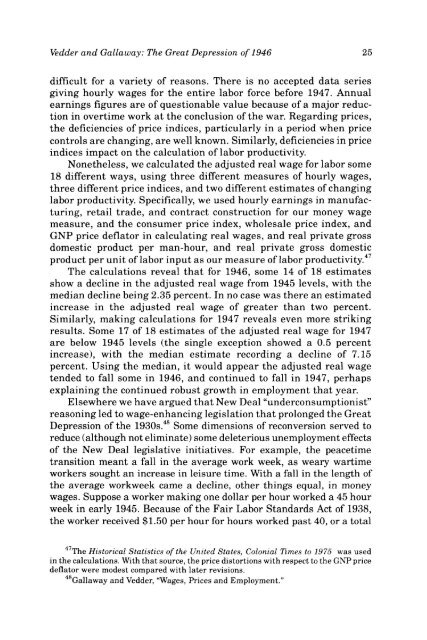Review of Austrian Economics - The Ludwig von Mises Institute
Review of Austrian Economics - The Ludwig von Mises Institute
Review of Austrian Economics - The Ludwig von Mises Institute
You also want an ePaper? Increase the reach of your titles
YUMPU automatically turns print PDFs into web optimized ePapers that Google loves.
Vedder and Gallaway: <strong>The</strong> Great Depression <strong>of</strong> 1946 25<br />
difficult for a variety <strong>of</strong> reasons. <strong>The</strong>re is no accepted data series<br />
giving hourly wages for the entire labor force before 1947. Annual<br />
earnings figures are <strong>of</strong> questionable value because <strong>of</strong> a major reduction<br />
in overtime work at the conclusion <strong>of</strong> the war. Regarding prices,<br />
the deficiencies <strong>of</strong> price indices, particularly in a period when price<br />
controls are changing, are well known. Similarly, deficiencies in price<br />
indices impact on the calculation <strong>of</strong> labor productivity.<br />
Nonetheless, we calculated the adjusted real wage for labor some<br />
18 different ways, using three different measures <strong>of</strong> hourly wages,<br />
three different price indices, and two different estimates <strong>of</strong> changing<br />
labor productivity. Specifically, we used hourly earnings in manufacturing,<br />
retail trade, and contract construction for our money wage<br />
measure, and the consumer price index, wholesale price index, and<br />
GNP price deflator in calculating real wages, and real private gross<br />
domestic product per man-hour, and real private gross domestic<br />
product per unit <strong>of</strong> labor input as our measure <strong>of</strong> labor productivity. 47<br />
<strong>The</strong> calculations reveal that for 1946, some 14 <strong>of</strong> 18 estimates<br />
show a decline in the adjusted real wage from 1945 levels, with the<br />
median decline being 2.35 percent. In no case was there an estimated<br />
increase in the adjusted real wage <strong>of</strong> greater than two percent.<br />
Similarly, making calculations for 1947 reveals even more striking<br />
results. Some 17 <strong>of</strong> 18 estimates <strong>of</strong> the adjusted real wage for 1947<br />
are below 1945 levels (the single exception showed a 0.5 percent<br />
increase), with the median estimate recording a decline <strong>of</strong> 7.15<br />
percent. Using the median, it would appear the adjusted real wage<br />
tended to fall some in 1946, and continued to fall in 1947, perhaps<br />
explaining the continued robust growth in employment that year.<br />
Elsewhere we have argued that New Deal "underconsumptionist"<br />
reasoning led to wage-enhancing legislation that prolonged the Great<br />
Depression <strong>of</strong> the 1930s. 48 Some dimensions <strong>of</strong> reconversion served to<br />
reduce (although not eliminate) some deleterious unemployment effects<br />
<strong>of</strong> the New Deal legislative initiatives. For example, the peacetime<br />
transition meant a fall in the average work week, as weary wartime<br />
workers sought an increase in leisure time. With a fall in the length <strong>of</strong><br />
the average workweek came a decline, other things equal, in money<br />
wages. Suppose a worker making one dollar per hour worked a 45 hour<br />
week in early 1945. Because <strong>of</strong> the Fair Labor Standards Act <strong>of</strong> 1938,<br />
the worker received $1.50 per hour for hours worked past 40, or a total<br />
47 <strong>The</strong> Historical Statistics <strong>of</strong> the United States, Colonial Times to 1975 was used<br />
in the calculations. With that source, the price distortions with respect to the GNP price<br />
deflator were modest compared with later revisions.<br />
48 Gallaway and Vedder, "Wages, Prices and Employment."

















